The Land
The history of the land that now encompasses E.P. “Tom” Sawyer State Park can be traced back hundred of years to the Shawnee tribes who once called most of what is now Kentucky home. However, our story begins nearly two hundred and thirty years ago. Several hundred acres of what is now eastern Jefferson County were awarded to noted Virginia frontiersman Isaac Hite for his service as an officer in the Virginia Militia during the French and Indian War. (1754-63).

After many years of surveying and having established a small settlement near Harrodsburg Kentucky, Hite traveled back north and finally settled on his land around 1784. The settlement was established near what today is known as the city of Anchorage. Along what is now known as Goose Creek he then constructed a mill and tannery, along with establishing a farm on the surrounding acreage. Hite christened his land “Cave Springs Plantation”, naming it after the fresh water stream that came from a cave on his property. Although it should be noted that in John Filson’s 1784 “Map of Kentucke” which scholars consider to be the earliest published map of Kentucky, Hite’s settlement is identified simply as “Hite’s Mill”. In later years this area would come to be known as Lakeland, due to the small spring-fed lake constructed in 1852 by local nurseryman Simeon L. Garr of Anchorage, who later became President of the Central Asylums Board of Commissioners. Four years later in the summer of 1788, the 35-year-old Hite married 20 year old Harriet Smith, and begin raising a family. Over time the plantation prospered, and eventually grow to encompass over 400 acres.

Isaac Hite continued prosperity would only last a few years when on February 22, 1794, the homestead was attacked by a Shawnee tribe. Hite was gravely wounded during the attack and died soon after. The land and house, as well as his businesses were bequeathed to his wife and four small children. Hite’s plantation remained in the family for several more generations until a parcel of 240 acres was sold by James and Eliza Hite to the Commonwealth of Kentucky in 1869 for the sum of $75,000. The states plan for the land was the establishment of a “State House of Reform for Juvenile Delinquents” passed in a February 15, 1869 act of the Kentucky legislature. This deal included not only the Cave Springs land but also any buildings contained therein. The Hite property was considered to be more than adequate. With deeds secured, construction began on the new main children’s home as well as an adjoining workshop. Other preexisting buildings were put to new uses, including the family homestead which was converted into the school or “family” building as it was called. Several months later, construction was completed and the House of Reform officially opened July 1, 1871.
The Asylum

By the early 1870’s severe patient overcrowding at both the Eastern and Western State Lunatic Asylums in Lexington and Hopkinsville necessitated a drastic change in the way the state housed and cared for its mentally ill. An act of the Kentucky General Assembly on April 21, 1873 authorized the establishment of two additional mental asylums. With this came the renaming of the Eastern and Western Asylums into the First and Second Lunatic Asylums, while the Institution for Feeble-minded Children in Frankfort and the House of Reform would be converted into the Third and Fourth respectively. Given its close proximity to Louisville, an already established building structure, and serene wooded setting the Lakeland location was considered ideal for such a facility.
Later that same month, Governor Preston H. Leslie appointed noted psychologist Dr. Chastine Caldwell Forbes as the first superintendent of the Fourth Asylum and R.K. White as president of the Board of Commissioners. An organizational meeting was held the evening of May 1st at the Reform home. It was during this meeting that the Board of Commissioners was formally organized and appointments for Secretary, Treasurer, and Matron officers also took place.
Under Dr. Forbes and the Board of Commissioners’ direction, major renovations on the former Reform Home were undertaken. Within the main building, patient wards were constructed, and new medical facilities were established. The Asylum unofficially “opened” on Thursday August 8, 1873, with assistant physician Dr. Thomas W. Gardiner welcoming the first 21 patients relocated from the Second Asylum, despite only having only one ward fully completed in which to house them. On September 1, Twenty female patients arrived from the First Asylum, and on October 1st, another twenty female patients arrived from the Second Asylum. On October 15, 1873 when Governor Leslie formally dedicated the building, the patient population had quickly increased to 157, as more transfers arrived from Kentucky’s three other asylums.
A later legislative appropriation of $33,000 allowed for the construction of separate accommodations for the African American patient populace. The appropriation specifically stated that “the colored and white shall not be kept in the same building.” Sadly, segregation was still a prominent issue in the minds of state officials and society in general. The new segregated wards offered amenities and dining facilities for both male and female “Negro lunatics” as they were then called, yet were substandard as compared to the conditions in which the white patients resided.
A legislative act in winter of 1873 again renamed the State asylums. The First, Second, and Fourth, became the Eastern, Western, and Central Kentucky Lunatic Asylums respectively. The Third asylum once again became known as the Home for Feeble-Minded. Meanwhile, although the Central asylum had not yet been open for a year, it was discovered that nearby Garrs Lake from which the asylum received their water supply was grossly insufficient and construction soon began on a water reservoir designed by Charles Hermany, a noted local engineer. Built adjacent to the small lake and to the rear of the main building, its purpose of the reservoir was to hold and conserve water for the hospital. It was later completed by early 1875 and the further enlarged in 1879. In later years the reservoir was named after Superintendent Dr. Malcolm H. Yeaman who served from 1904 until 1907.
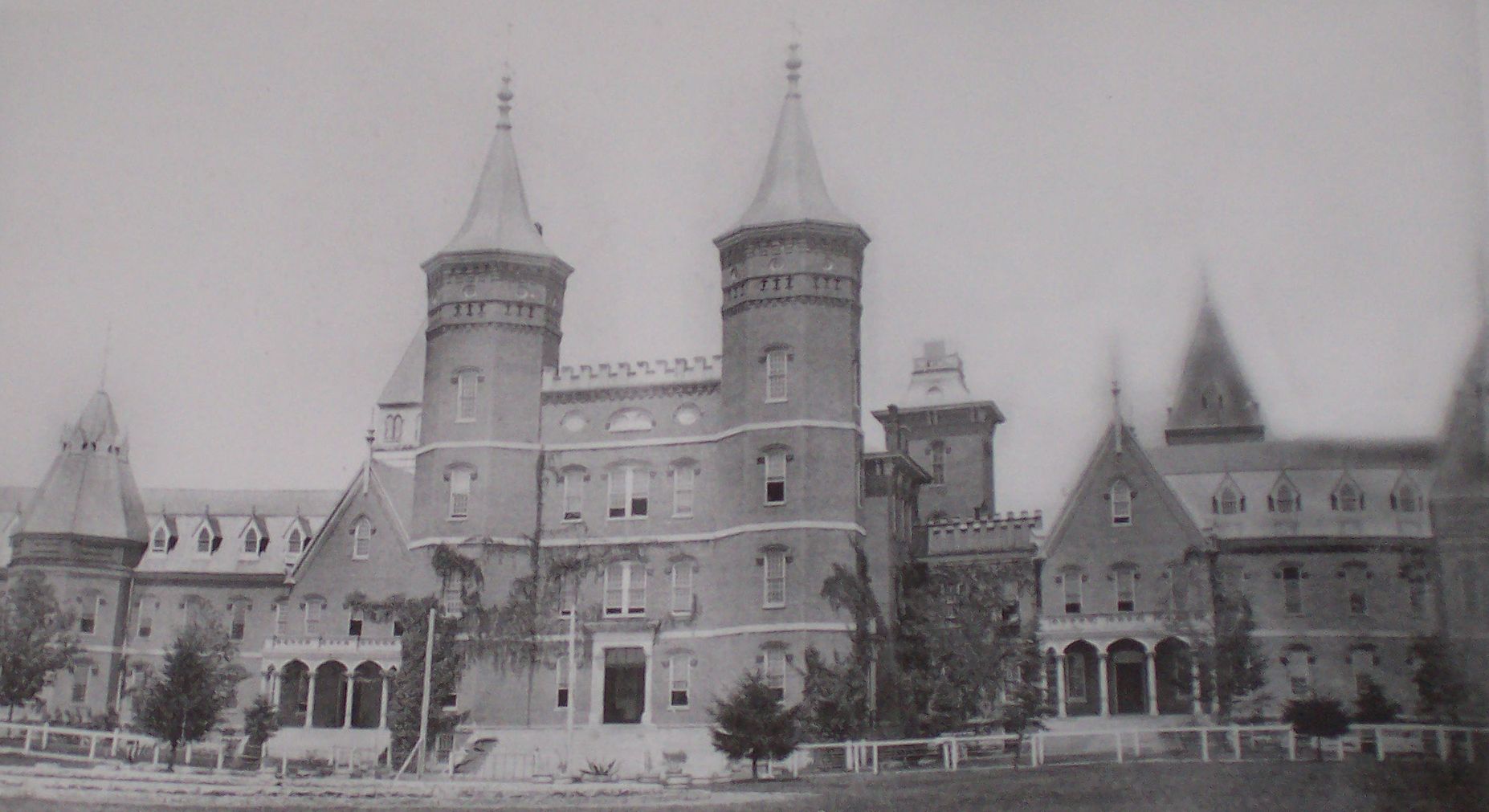
In an effort to accommodate the steady increase in patient admissions more land was purchased and new wards were constructed including a new main asylum building. The design for the new asylum was chosen in accordance to the then popular architectural design of famous psychologist Dr. Thomas Story Kirkbride. Kirkbride’s self-named hospital construction style became typical of asylums in the late 19th century, though it was more commonly known as the “bat wing” or linear plan. The general layout of such buildings consisted of a main administration building with tiered “wings” or wards adjacent to them. Though the asylums main architects name has been lost to time, John Andrewartha, a local architect who designed Louisville City Hall was consulted on extensions and additions to the building in 1874. Each ward would then be set further back from the previous. According to procedure, those patients considered to be more “excitable” were kept in the furthermost wards, while patients who were more rational and behaved were kept in wards in closer proximity to the main building.
Due to a hazardous winter and harsh spring, the eastern wing, meant to house female patients was not completed until late April 1875. The western men’s wing was ready for occupancy by early July of that same year. A chapel was established on the first floor of the main building. The kitchen and dining spaces were constructed in the basement. To the North, the additional acreage of the Asylum meant that the garden, established during the era of the Reform Home, allowed for the expansion of the garden and dairy farm and the establishment of an orchard. This increased production not only made the hospital more self-sufficient, but it also meant that surplus goods could be sold as extra income. As expected, it was not unusual for the more “reasonable” patients to be used to work as free labor, under the guise of “therapy”. Today you can still see the remnants of the orchard, the dead trees perfectly lined up in rows.
Dr. Forbes resigned his post in September of 1879, and would later be appointed the first superintendent of the Arkansas State Lunatic Asylum in 1883. Later that month his successor Dr. Robert Gale continued to see the institution grow and expand, as the patient population rose to 462 in-house residents his first year.
Later in 1879 the natural limestone cave, which is still in existence, about 600 feet north of the asylum – was excavated and lined with brick walls, a water way was constructed from left over cement from the construction of the water reservoir, the cave became a refrigeration space for the asylum’s daily milk supply.

As early as 1882, reports of patient neglect and abuse began to arise. Numerous incidents of ward attendants “ducking” (nearly drowning) patients considered “unruly” or troublesome began to be investigated. An incident of “ducking” that resulted in the drowning death of a patient named Jansen led the Board of Commissioners convening a formal inquiry on September 21, 1882 to review such incidents. The inquiry consisted of multiple interviews with numerous staff members including Superintendent Dr. Robert Gale and his Assistant Dr. G. T. Erwin. Both of these men were later exonerated of any negligence under their watch. Shortly thereafter in 1884, by sad coincidence Dr. Gale would pass away on the very day his resignation was to take effect. Governor J. Proctor Knott appointed Dr. Henry Pusey to the office later that same year to replace Gale.
Pusey’s two non-consecutive terms in office were notable for not only the high standards in which he ran the asylum, but the extensive renovations and new ward construction undertaken as well. Under his tenure, the first post office was established on November 4, 1887, under the name “Asylum”. Ms Mary E. Whips served as its first postmaster, but by March of 1888 the post office name was changed to “Lakeland” as the proper area was titled.

On April 24, 1893, an Act of the General Assembly officially proclaimed that the post office was to be located in Anchorage. This same act renamed the asylum once again as the Central Kentucky Asylum for the Insane. By this time the term “lunatic” had become considered inhumane and derogatory to patients, and had fallen out of use as a proper medical term. In the years to follow, many local residents would continue to refer to it by various names: the “Anchorage Asylum”, the “Lakeland Hospital”, “Lakeland Asylum” or simply “Lakeland.”
Dr. Pusey’s first tenure with the asylum was short lived. When Simon B. Buckner was elected Governor in 1887, he requested Dr. Pusey’s resignation. Governor Buckner appointed Dr. Walter J. Byrne as superintendent for political reasons. Buckner’s act brought massive public outcry due to Dr. Pusey’s successful administrating and respected reputation. During this time the new African American ward building opened in October of 1898.
Byrne continued to serve as Superintendent until 1891, when Governor John Y. Brown reappointed Pusey to the office once again. When Pusey returned, he found the Asylum in roughly the same condition as when he had first taken over in 1884. During Byrnes administration, the state has reduced the patient per day allotment from $1.50 to $1.35, as it was when Pusey first took office. Still, with the Asylum underfunded and understaffed, Pusey continued to push for improvements and better patient treatment.
In early 1890 the first “open building” ward for the male population was dedicated. With a capacity of 225 patients the building would later be named in honor of Dr. Pusey in recognition for his years of service.
As was noted in the 1895 annual report to the Kentucky General Assembly, the Asylum population had risen to 1,083 patients by October of that year causing overcrowded conditions. Due to his failing health, Dr. Pusey resigned his position as superintendent in 1896 and retired to Louisville, later passing on September 1, of that same year at the home of his daughter and son-in-law. His replacement Dr. Hugh McNary’s term in office lasted a little more than a year before dying of a heart attack on May 12, 1897, while at the home of his sister.
The Hospital
The dawn of the 20th century brought several more changes to the hospital and its vast acreage. To the east of the main building a new industrial and amusement structure was constructed in 1903 and dedicated on August 8, of that year.

The amusement hall contained a sewing area, a billiard room, dance hall and chapel for patient use. The second floor housed another female ward. It was also one of the last buildings to be demolished in 1996 when the land was being converted for park use. Several cases of patient abuse also began to arise again in 1903. Following a lengthy in depth investigation several ward attendants were indicted. In April 1906, by an act of the Kentucky Legislature, the Board of Commissioners was dissolved and Central was then put under the auspices of four person bi-partisan “Kentucky State Board of Charitable Institutions”, along with the other asylums and institutions in Kentucky.
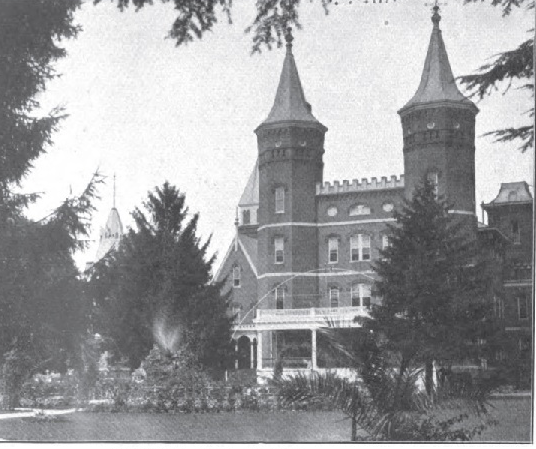
During the 1908 session of the General Assembly $25,000 was allotted for the improvement of heating and water systems, with an additional $65,000 allotted to cover the expenses for the construction of a water basin, the laying of pipe, pumps and other apparatus in order to bring the asylums water supply up to modern standards. That same year the increasing number of Tuberculosis cases at the asylum necessitated the construction of a tubercular cottage for patients at a cost of $15,000.
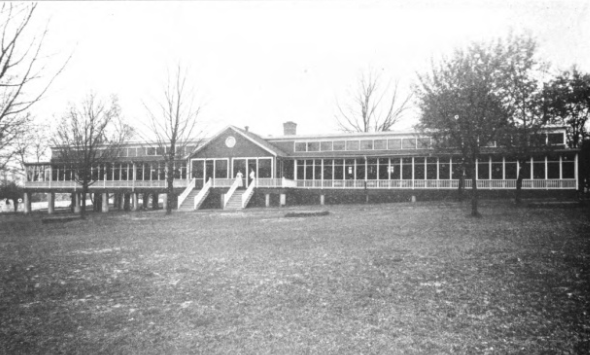
The planned location was an area between the main building and the Pusey building. Designed by the noted Louisville architecture firm of D.X. Murphy and Co., it was a one-story structure with an open front porch that spanned the length of the building. A fire eventually destroyed the cottage on November 26, 1917. Fortunately, all 29 patients quarantined survived the blaze.
Throughout 1911, many extra curricular activates were established for patients. A library located on the first floor of the Oakwood Building was founded under the direction of Miss Della King. It consisted of over 860 books and had been allotted an annual fund of $250 for the continued purchase of new reading materials.
According to the 1910-1911 biennial report from the Kentucky Library Commission, the asylum was the only Kentucky institution that reported a regular book fund. Also in that year, motion pictures began to be shown in Oakwood. Beginning on October 1, 1911, a three-year nurse training school was established on site. This program brought a better, more trained staff of ward attendant and medical care to patients.
An act of the Kentucky General Assembly on March 14, 1912 proclaimed that from there on out the asylum would be known formally as “Central State Hospital”. Later that same year on September 4th, Central States electric light and power plant also caught fire, a loss estimated at $12,000.

Also, by October 1, 1912 the total real estate had grown to 540 acres, most of which went to more farmland and orchards. As was noted in the 1913 annual report to the Governor of Kentucky, the patient population had risen to 1,252 once again pushing the hospital almost to overcrowding with a per capita allowance of $150 per patient. Also that year, the first eight nurses from the training school graduated. After several decades of having an insufficient water supply for the Asylum, in 1914 it was finally connected to a main from the Louisville Water Company after a $65,000 appropriation from the State Legislature. The 1915 Kentucky Directory listed the population at 1,659, by 1917 1,732 patients called Central State home.
In 1919, Dr. Frank Peddicord would resign and be temporarily replaced by Dr. Squire L. Helm, then Superintendent of the Home for Feeble-Minded in Frankfort until Dr. Walter A. Jillson assumed the position on August 8, 1920. Helms short tenure was was marked by a steady decline in the condition of the hospital, mostly due to lack of funding from the first World War rationing. In his first report to Governor Edwin P. Marrow, Dr. Jilson began by stating “This hospital is grossly undermanned and overcrowded.” He would then go on to list numerous problems in the first 6 pages of his report. Jillian quickly made it his mission to raise the standards of the hospital and adopt more modern medical approaches. It was during Jillson’s tenure in the early 1920s, that hydrotherapy and hypnosis were first used as common patient treatments. Another treatment of note was “Deep Sleep” therapy, a treatment using barbiturates as pioneered by Swiss psychiatrist Jakob Klaesi. In 1921, allegations of patient abuse and neglect again became an issue, and the hospital staff investigated.
In the 1922 Kentucky Medical Journal, for instance, former Superintendent Dr. William E. Gardner wrote a report describing how 30-40 patients had contracted pellagra. The cases were later found to stem from the consumption of unrefined corn, which had grown on the asylum farm.
By 1923 Central State had now grown to encompass 562 acres. Of that territory, 54 acres contained the main buildings, parks, and grounds for the institution. The hospital now consisted of 24 separate buildings including the administration building, 9 dormitories, the African american ward building, tuberculosis shack, the industrial shop, a garage, kitchen, store rooms, laundry, power house, amusement hall, green house and the Pusey building which by this point now housed mostly ex-service men. 240 other acres were used as pasture, and the remaining acreage had been cultivated for the raising of crops used for the hospital. This was much needed as the patient population had now risen to 1,869. In June 1927, $44,740 was allotted by the state for the erection of a two-story From a brick hospital for the criminally insane with a capacity to house 66. Up until this time these patients had been kept in wards amongst the general population. It was during this time that on November 7, 1928, that Superintendent Wallis W. Durham would pass away from acute pancreatitis. He was replaced by Assistant Superintendent Dr. C. B. Dunn until Dr. J. Ernest Fox assumed the position. After nearly a year and a half, construction was completed on the two story brick building located to the far west of the property past the African-American ward. It opened officially on January 29, 1929. A short time later that year on March 4th, the refurbished Superintendents home on Lakeland Road was ready for reoccupation.

Due to an appropriation from the 1928 General Assembly, a two-story brick congregate dining room and dormitory were constructed to the eastern rear of the Administration building. It was completed on October 1, 1930. This would later be known as Cardinal Hall. Even with the new buildings being built on the now 652 acre campus, overcrowding became a prominent issue again. As was noted in the 1931 annual report there were well over 2,200 patients scattered in buildings designed to accommodate only 1,800, a 22% excess. The population at Central continued to rise and by 1938, there were 2,367 patients. This put the overpopulation total at 567. As with the other state hospitals at the time, Central was continuously understaffed. With three assistant physicians on staff and one part time physician, the ratio of Doctor to patient was 1-676. With the nursing staff counted at 141, the ratio was 1-19.
Keeping up with the latest in psychiatric treatment found similar mental hospitals, Central State began using new and in some cases, what would today seem barbaric treatments in the mid-1930’s. These included various types of “shock therapy” such as insulin, and electroconvulsive or electroshock therapy. The notorious partial or frontal lobotomy would also find its way into use at Central State around this time, a practice that continued until the 1960’s when its usage was finally deemed harmful and inhumane.

Into the 1940s conditions continued to be substandard. Due to the low per-capita Central received, roughly 10.62 cents a day went to patients daily meals. A sample menu consisted of one piece of bacon fat, navy beans, syrup, bread and water to drink. During an in-depth investigation conducted in February 1941, the Kentucky State grand jury highly criticized Central State due to several of the wards being in a state of deterioration that the Jury saw as “considerable overcrowded more than the usual and ordinary fire hazard.” The jurors described the stench in several of the wards as “awful.” They also recommended that the Operating and X-Ray rooms, which were located in the Administration buildings basement be moved to the First floor and brought up to modern standards as soon as possible. With money allotted from the State, major improvements were undertaken by May. Along with relocating both the Operating and X-ray room, other parts of the Administration were renovated. Also among the improvement plans were total renovations of many of the hospitals nearly 70-year-old old buildings.
In early 1942 restoration began on the 65-year-old Pusey building. This consisted of a nearly complete interior renovation at a cost of $135,000. These improvements now added addition living quarters for 362 patients, thereby relieving some of the overcrowded conditions in other hospital wards. On October 16, 1942, Governor Keen Johnson announced that $907,000 would be allotted to the states charitable facilities, with $100,000 given to Central State for “differed maintenance” and $5,000 for new coal storage bunkers. The differed title for the money was due to financial priorities during World War II, as new construction projects was not permitted. Nevertheless, many of the buildings that had been undergoing renovation and reconstruction were left unfinished due to insufficient funds during the war years. This left many new medical facilities unusable and patients without completed wards in which to be housed, again exacerbating overcrowding within the other wards.
At a meeting held at Central State on December 8, 1942, Governor Johnson announced a pay increase of $5 a month to all state facility employees earning $71.50 or less a month. Governor Johnson later dedicated the refurbished Pusey building on July 12, 1943. It was during Governor Johnson’s administration that an emergency $520,547,41 was to be expended to modernize Central State in compliance with government regulation. In 1944 plans were underway and blueprints were drawn up for a near complete remodeling of the administration building. These plans however, were considered too costly and were soon abandoned in favor of some minor remodeling of the buildings interiors. Superintendent Isham Kimbell also resigned later that year, while former superintendent Dr. Frank Peddicord served as acting head until a replacement could be found.
When Dr. Addie M. Lyons took over as Central State superintendent in 1944 he found cases of patients having been committed under false pretenses and miss-diagnosed. Among these was a 105-year-old African American man who had been committed for spitting on a courthouse stove. He swore to make it his job to release such patients, and modernize the hospital and its practices.
With the renovation of one of the 190-bed capacity male wards finally completed in 1945, a dedication was held on April 18th of that year. In his speech Governor Simeon Willis expressed gratitude to Dr. Lyon for the superb work of doing “two men’s jobs”. As Dr. Lyon was then concurrently serving as the Director of the Division of Hospitals and mental hygiene as well as the superintendent of both Central and Western State. Later, on October 26th of that year, Gov. Willis would also dedicate the completed Mary E. Merritt building for the African-American patients.
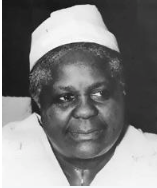
The $500,000 building was named after Mary E. Merritt who was the first African-American nurse to be licensed in Kentucky as well as superintendent of nursing at the Red Cross Hospital in Louisville, Kentucky from 1914 until 1945. Still questions about the quality of care continued to hound the institution. During a surprise inspection conducted in 1948, the Grand Jury described the hospitals kitchen area, its services, and the food being served to patients as “garbage.” Dr. Lyon responded to the criticism calling it “unfair and vicious” as the hospital was in the process of constructing a new state-of-the-art kitchen. On October 31st of 1948, a patient canteen was opened for business under the management of a Mr. Hall.

By 1951, Central State Hospital, as well as the other state mental institutions had come under the control of the Division of Hospitals and Mental Hygiene, itself part of the Division of the State Department of Welfare. Also, the west original Kirkbride wing was demolished and construction began on a new modern ward for female patients, which was completed in November of 1952. This wing was dedicated in April 1953 to Dr. Lyon for his many years as Superintendent. From September 1953 through September 1954, it was noted that there were reports of over 20 separate fires and murders among the hospitals wards as well as multiple escapes. One fire, occurring on December 2, 1953, destroyed the hospitals laundry building.

Dr. Frank Alfano, the physician in charge of the African American ward, made news when he contacted state inspectors in early April 1953, bringing to light the poor conditions at Central State, particularly the African-american Merritt building. Underfunded at its inception and hastily constructed, the Merritt building was a prime target when on April 21, the state grand jury made a several hour unannounced inspection of the hospital. Due to the jury’s findings Dr. Lyon, as well as business manager W.G. Kincaid were later indicted for malfeasance and mismanagement. Judge Frank A. Rophe eventually acquitted both men on May 29th of that year after a second inspection, but Dr. Lyon nevertheless tendered his resignation at Central State shortly after the acquittal. Dr. George P. Wyman became the new superintendent.
Starting in 1954 Central State Hospital began conducting intensive clinical pastoral education for students from the Southern Baptist Theological Seminary. In July of 1956, the hospitals first Patient Government Assembly was organized and later that year a new ward for children opened, thanks to a grant from the Louisville Crusade for Children. It was also in that year, Central became fully racially integrated, under the Hill-Burton Act.
The hospitals first Boy Scout troop was organized in 1957 as the Dr. Frank Gaines Post of the Old Kentucky Home Council. In June of 1958, the state auctioned off 337.58 acres of former farmland and 6 homes on the property for future use as a subdivision for $389,146, after a deal to sell the land to the Reynolds Metal Company twice fell through due to rezoning failures. In early May 1959 the old wooden frame Tuberculosis “Q” building built in 1919 was demolished.
In a state budget address given on Feb 17, 1960 Governor Bert Combs recommended an increase of $3,397,000 for the Department of Mental Health. This plan would raise the average daily expenditure per patient from $3.63 to $4.43, in addition to begin the process of constructing new buildings at Central State. Included in the Governors plan would be a new 204-bed admission and treatment building, a 66-bed minimum-security unit, and a 50-bed children’s unit. Also included in the plan was a new storage and refrigeration building.

The next year a modernist statue designed by University of Louisville associate professor of sculpture John D. Prangnell was unveiled at CSH entitled “Mother”. It was placed near the front entrance of the Merritt building. It was thought that the statue would be a calming presence to the patients, particularly the children. Although Governor Combs proposal for newer facilities for CSH had been in discussion for several years, inadequate funding made these plans fortuitous. However in December 1962 with state government funding finally obtained, construction began on what was to be the first of five new facilities for CSH. The proposed new site would be adjacent to the old buildings property and be bordered by Lakeland and LaGrange Roads. The modern thirty-eight-bed rehabilitation building was estimated at a cost of $1,000,000. By 1963 several other of the newer buildings had been constructed, these included a new main administration building, dormitories, a corrective psychology center, occupational therapy building, a power plant and also a gymnasium. However these new buildings were neither fully completed nor adequate to be occupied as of May 1963. It would be nearly another three years until all seven buildings on the new campus would be utilized.
Plumbing and electrical work had yet to be completed when patients began using the facilities that next year. Dr. Walter Fox would resign as superintendent on May 20, 1965 after having served in that position since 1956. Fox had been outspoken about his displeasure with the lack of financing for completion and staffing of the new buildings. Dr. Ray H. Hayes, who had been clinical director at Central State, would succeed Fox. During his tenure as superintendent, Dr. Hayes initiated a therapy for treating alcoholism that involved having the patients work at the hospital in various jobs, including janitorial duties, to help them feel productive. In the late 1960s Hayes criticized institutionalized care as an ineffective way to treat criminals. “Large institutions can be the most pernicious … things we can build,” he said at a state conference. “People begin to be buried alive there.” On July 21, 1967 Central State along with Louisville Memorial Hospital were awarded 3-year accreditation, the highest accreditation a hospital can receive. In the fall of 1969 The 80-year old Shelby building was closed permanently, while the Jefferson building, which at one time housed the original African American ward, was renovated into a new Children’s unit for psychologically disturbed children.
Dr. Hayes would resign as Central States superintendent later that year in December to become an associate professor at the University of Louisville. He was succeeded by Dr. David E. Irogoyen, under the title of Director, as the term “Superintendent” was considered outdated. Dr. Irogoyen who had been serving as the hospitals chief of medical staff, had been with Central State since 1961. The last year of the decade saw the state finally release many patients considered not truly mentally ill, to be directed toward decentralized clinics for new medications and social services. Many former patients would have problems adjusting as well as finding assistance. Some would find themselves living on the streets.
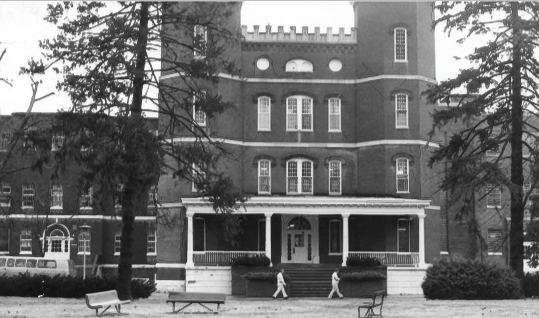
By early 1970 much of the unused farmland from the hospital was converted by the State of Kentucky for what would be known as E.P. “Tom” Sawyer State Park, which named in honor of Jefferson County Judge Executive Erbon Powers “Tom” Sawyer, father of famed news anchor Diane Sawyer, who died in 1969. Governor Louie B. Nunn formally dedicated the park in autumn of 1971. In addition, the hospitals 450-acre farm was returned to state control for use by the Jefferson Area Vocational School at Jeffersontown. Older buildings such as the barn, built in 1946 were converted for use as a machinery shop and for other horticultural uses. It was during this time that renowned playwright Marsha Norman took a job at CSH teaching mentally trouble youth, while pursuing her master’s degree at the University of Louisville. This experience laid the foundation for some of her later plays such as the award winning “Getting Out”.
In 1971, Dr. Irogoyen accepted a position as Deputy commissioner of forensic psychiatry for the state of Kentucky and resigned, with Dr. Lawrence Mudd becoming the new Director. Also that year, the state mental institutions were converted to the geographic unit system. In the past, hospital patients had been placed on wards according to the problem or diagnosis. Under the geographic unit system, residents were placed on wards according to the geographic area of the state from which they came. 1972 saw the opening of the newly constructed Children’s Treatment Service Building, providing young patients more modern living conditions than being housed in the aging Merritt Building.
River Region
On July 1, 1974 Central State became privatized under the auspicious of River Regional Mental Health Board as a part of a venture between the State and River Region to merge in-patient and community based care, while increasing the flow of federal dollars into the Kentucky system. This lead to the state transferring control of all Lakeland facilities to River Region and the hospital being renamed as River Region Hospital. As part of the deal, the state would continue to provide forensic psychiatric services at the hospital as well as finance the children’s center there. Ohio native Johnny Morrison was appointed as River Regions new administrator. Later that same month, a major change came to the appearance of the hospital as the nearly 100-year old signature spires that adorned the facade were removed due to their deteriorating condition.

River Regions tenure would be filled with inadequate funding, under staffing, and general mismanagement. The hospital operated from July 1975 through March 1976 with nearly a $1,000,000 deficit. Many of the hospitals finance problems stemmed from delayed reimbursement from federal medical sources, such as Medicaid for many patients. Even with grants from the state, the operation of the hospital nearly bankrupted River region. Three years to the day after they had assumed control, the River Regions Board of Directors voted to return the hospital and State resumed control of the facilities on July 1, 1977. Once again, the hospital became known as Central State.
Modern Care
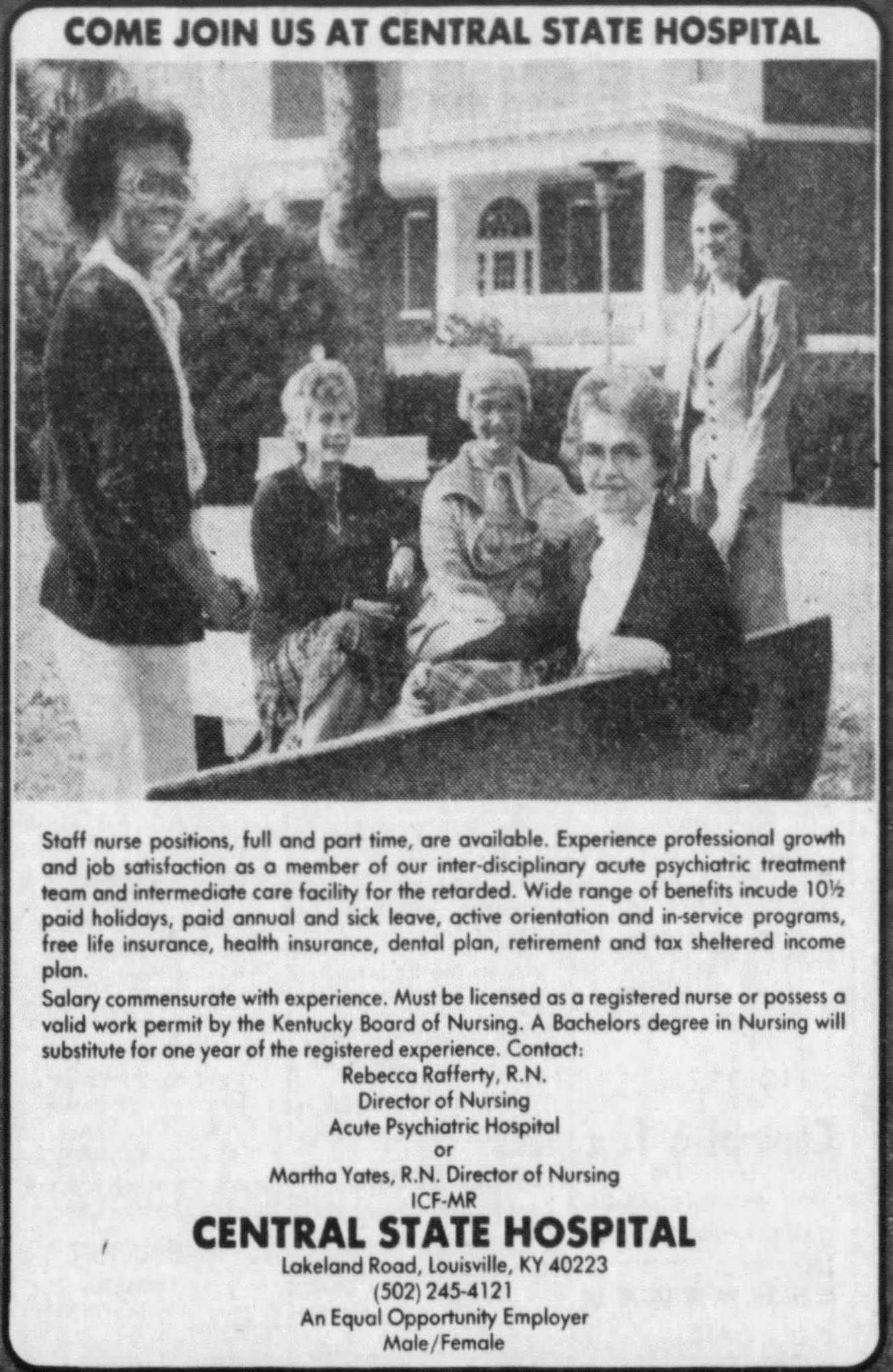
With the return of the hospital to state control, more out-patient care, and medicinal therapies by 1979 the in-house patient population at Central State decreased to 275. This led to many of the older buildings being closed and sitting unused. In 1983 a practice considered highly controversial at the time made a return as a treatment at Central State after a moratorium of nearly 10 years when Doctors began using electroshock therapy on patients again. That same year the Kentucky Mental Health Board realized that a newer and more modern facility was in desperate need at Central State. The original administration building was well over 100 years old and many of the newer buildings from the 1960’s were now inadequate for in-patient care. With the state of Kentucky allotting the funding, a new modern $7.7 million 92-bed facility was planned on La Grange Road adjacent to the 1960s “new campus” buildings.
Groundbreaking took place on December 8, 1983. Beginning in the early months of 1986, many of Central States older buildings were demolished, among them the Pusey Building, Occupational Therapy and the former Superintendents residence, leaving only the old administration and adjacent Oaklawn building standing. In August of that year, Central State lost it’s U.S. certification and funding due to a lack of nursing staff. Finally, in October of that same year, after a 16-month delay, construction was completed on the new main hospital building and the formal dedication took place on November 14, 1986.
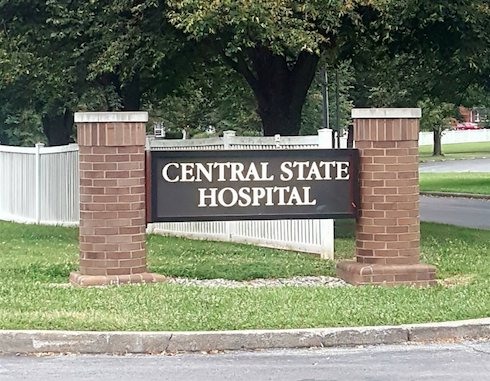

In the following years, Central State would come under fire throughout the remaining years of the 1980s and early 1990s with multiple patient escapes and the release of convicted child murderer, Todd Ice. Since the opening of the new hospital, the original administration and Oaklawn building remaining on the old Lakeland Road “north campus” became used mainly for storage. In 1990 the Administration Building became occupied for several years to the Jefferson County State Vocational-Technical School until it relocated to a new downtown location at 8th and Jefferson Streets. Over the following years both remaining buildings fell into a state of dire neglect. As with similar sites, the hospital and the remaining buildings grew to be considered a place ripe for urban legends and ghost stories. Numerous thrill seekers dared to climb the fences, venture in, and walk the halls of the once stately buildings. Their only companions being shadows and echoes…

However, after many years of debate and planning, in 1993 the state of Kentucky estimated a cost of $2.8 million to demolish or rehab all of the remaining buildings on the 52-acre Lakeland site. After a failed attempt at auction off the property in April of 1993, The Central State Hospital Recovery Authority committee was organized in 1994 with the purpose of managing or finding a use for the old Central State buildings. It was finally decided that the Administration building and others were beyond saving due to the extravagant cost entailed, including asbestos removal. The plans now entailed that the buildings were to be demolished and the land was to be annexed to nearby Sawyer Park. In that time, the final estimated cost of demolition had doubled from $3 million to nearly $6 million. By 1997, demolition was completed and the razed buildings were covered over with dirt and left. However, some buildings such as the old barns and root cellars remained for use by Sawyer State Park.
In June of 1997 while taking a walk through the northern portion of the park, Anchorage resident Cecil Meek and his two grandchildren came across two headstones lying in a nearby creek. Their discovery and inquiries by local news media led Kentucky state officials to conduct an investigation into the location of the original hospital cemeteries.

According to Clarence Barton, the former chaplain at Central State from 1952 until 1988, by the time he began working there both cemeteries were already neglected and no longer in use. During his time there he constructed a crude fence around both of them.
The Central State Legacy
In 2003, Mrs. Jean Sawyer-Hayes, widow of both one time County Judge Erbon “Tom” Sawyer and former hospital superintendent Ray Hayes met with former Sawyer park director Rita Strosberg. Mrs. Sawyer-Hayes wanted to create a memorial to both of her deceased husbands. With matching donations from the foundation she had established and from the State of Kentucky, a location was selected near the site of the former African-American ward.

Ground was broken in 2008 and construction was competed the following year. The Sawyer-Hayes Community Center now serves as host to many events such as business meetings, family reunions, and wedding receptions. Even today, the legacy of Central State Hospital continues to live on. In 2010, two markers were erected adjacent to the old administration building’s main entrance. A third marker was placed near the old cemeteries. On these three markers are written not only collective history of Central State, but also the untold story of the tens of thousands unfortunate souls for whom it was the only home they ever knew…

Names Used by the Hospital
- Fourth Kentucky Lunatic Asylum (1873)
- Central Kentucky Lunatic Asylum (1874-1893)
- Central Kentucky Lunatic Asylum (1874-1893)
- Central Kentucky Asylum for the Insane (1893-1912)
- Central State Hospital (1912-1974) (1978-Current)
- River Region Hospital (1974-1978)
Contributed by Jay Gravatte | contact@kyhi.org
Important note:
If you would like to use any information on this website (including text, bios, photos and any other information) we encourage you to contact us. We do not own all of the materials on this website/blog. Many of these materials are courtesy of other sources and the original copyright holders retain all applicable rights under the law. Please remember that information contained on this site, authored/owned by KHI, is provided under a Creative Commons Attribution-NonCommercial-NoDerivatives 4.0 International License.
Photographs, text, illustrations and all other media not authored by KHI belong to their respective authors/owners/copyright holders and are used here for educational purposes only under Title 17 U.S. Code § 107.
